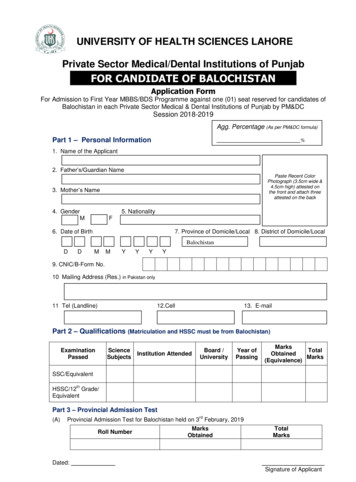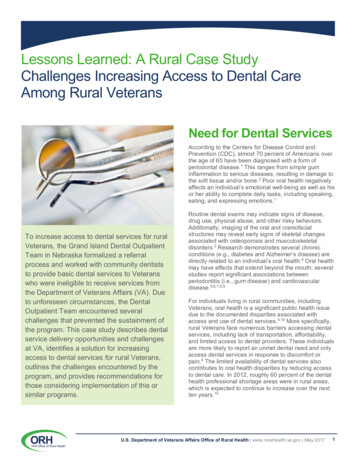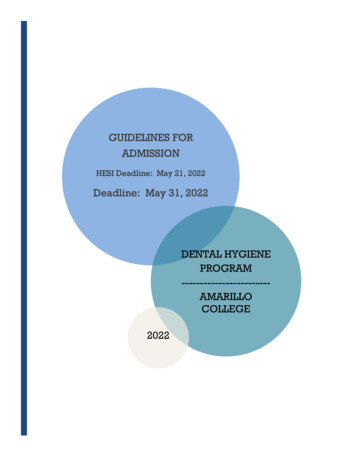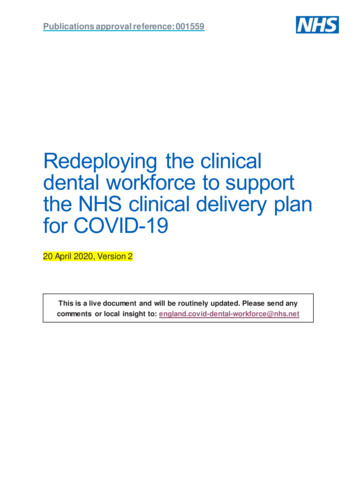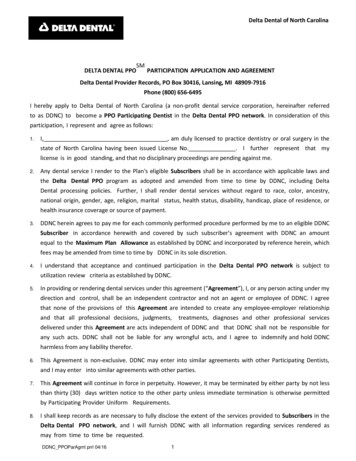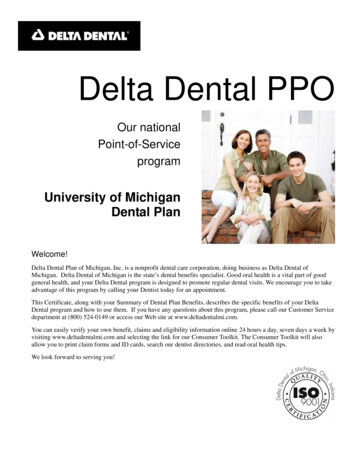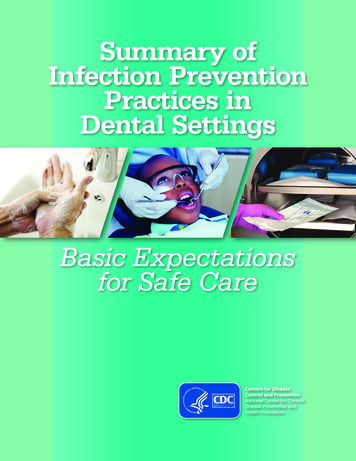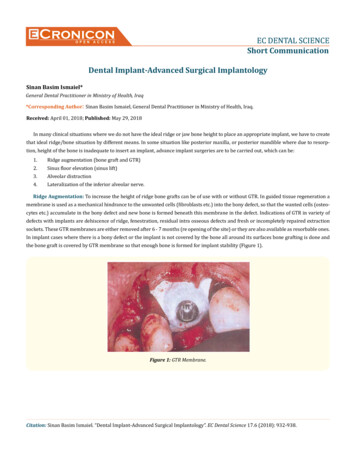
Transcription
CroniconO P ENEC DENTAL SCIENCEShort CommunicationA C C ESSDental Implant-Advanced Surgical ImplantologySinan Basim Ismaiel*General Dental Practitioner in Ministry of Health, Iraq*Corresponding Author: Sinan Basim Ismaiel, General Dental Practitioner in Ministry of Health, Iraq.Received: April 01, 2018; Published: May 29, 2018In many clinical situations where we do not have the ideal ridge or jaw bone height to place an appropriate implant, we have to createthat ideal ridge/bone situation by different means. In some situation like posterior maxilla, or posterior mandible where due to resorption, height of the bone is inadequate to insert an implant, advance implant surgeries are to be carried out, which can be:1.2.3.4.Ridge augmentation (bone graft and GTR)Sinus floor elevation (sinus lift)Alveolar distractionLateralization of the inferior alveolar nerve.Ridge Augmentation: To increase the height of ridge bone grafts can be of use with or without GTR. In guided tissue regeneration amembrane is used as a mechanical hindrance to the unwanted cells (fibroblasts etc.) into the bony defect, so that the wanted cells (osteo-cytes etc.) accumulate in the bony defect and new bone is formed beneath this membrane in the defect. Indications of GTR in variety ofdefects with implants are dehiscence of ridge, fenestration, residual intra osseous defects and fresh or incompletely repaired extractionsockets. These GTR membranes are either removed after 6 - 7 months (re opening of the site) or they are also available as resorbable ones.In implant cases where there is a bony defect or the implant is not covered by the bone all around its surfaces bone grafting is done andthe bone graft is covered by GTR membrane so that enough bone is formed for implant stability (Figure 1).Figure 1: GTR Membrane.Citation: Sinan Basim Ismaiel. “Dental Implant-Advanced Surgical Implantology”. EC Dental Science 17.6 (2018): 932-938.
Dental Implant-Advanced Surgical Implantology933Bone graft: Bone grafts are used to augment the ridge. Bone grafts can be autogenous or heterogenous, can be used as a block graftor bone chips. Sites for autogenous bone harvesting are mandibular symphysis, iliac crest, calvarium, ribs etc. Heterogenous grafts areavailable in blocks or granules in different shapes and sizes i.e. Bio-oss, Hydroxyapatite granules etc. According to the defect bone graftsare chosen (Figure 2a-c).Figure 2a: Defect.Figure 2b: GTR.Citation: Sinan Basim Ismaiel. “Dental Implant-Advanced Surgical Implantology”. EC Dental Science 17.6 (2018): 932-938.
Dental Implant-Advanced Surgical Implantology934Figure 2c: Bone graft.Sinus Floor Elevation: It is an internal augmentation of the maxillary sinus, intended to increase the vertical body dimension in thelateral maxilla in order to make the use of dental implants possible in the severely resorbed ridge in posterior maxilla.This procedure was introduced by Tatum in 1976, and modified by Tatum 1986, Chavanaz 1998 and many other workers. In a classicalsinus lift operation lateral wall of the maxillary sinus wall in a horizontal position is lifted to the new sinus bottom and the space createdunderneath the new sinus bottom is filled with bone grafts. This procedure is called direct sinus lift. Sinus lift can be achieved by liftingthe sinus floor by specially designed osteotomes to lift the sinus floor through the extraction socket and this method is called as indirectsinus lift procedure. Implants are inserted simultaneously or in a second stage surgery after 6 - 8 months of sinus lift and bone grafting.Operation1.2.Flap design: Usually the incision is made on the top of the alveolar ridge, or slightly on the palatal side, through the keratinizedattached mucosa and releasing incision is given in canine region.Making of bony window: A round bur is used to make a window in the antero-lateral wall of maxillary sinus. Two horizontaland two vertical cuts are made, bony window is separated on all the three cuts (2 vertical and lower horizontal cut) and hingedon the superior horizontal cut, which is fractured and rotated inward as a trap door and the space created beneath this newlyformed sinus wall is grafted by bone grafts (Figure 3a and 3b).Figure 3aCitation: Sinan Basim Ismaiel. “Dental Implant-Advanced Surgical Implantology”. EC Dental Science 17.6 (2018): 932-938.
Dental Implant-Advanced Surgical Implantology935Figure 3bDirect sinus lift procedure1.2.Implant insertion: It can be done in same time or as a second surgical procedure after 6 – 8 months, applying standard principles of implant surgery.Closure: Air tight closure of mucoperiosteal flap is the key. The anatomical variations in the sinus i.e. mucosal irregularities,sinus septa, sinus diseases/pathologies, thickness of the anterolateral wall needs to be addressed in sinus lift procedure. Asmucosal tear/perforation at the internal septa of maxillary sinus, or during elevation or detachment of sinus mucosa can affectthe outcome of this procedure tremendously, because graft success depends on the vascularity of the mucosa and the mucoperiosteum.Alveolar Distraction: By gradual stretching of an osteotomized bone, new bone formation takes place at the site of osteotomy. Thistechnique is being applied to lengthen long bones of body (Illizarov technique), since long and also being applied to correct facial deformities in maxillofacial surgery and on the same principles this technique is used to increase the alveolar bone height by distracting the neobone formation at the osteotomy site using different distraction devices. It is a new and promising method of ridge augmentation, wherewe don’t need any kind of bone graft (Figure 4a and 4b).Figure 4aCitation: Sinan Basim Ismaiel. “Dental Implant-Advanced Surgical Implantology”. EC Dental Science 17.6 (2018): 932-938.
Dental Implant-Advanced Surgical Implantology936Figure 4bAlveolar distractionWhen we achieve desired ridge height, distraction devices are removed and dental implants are inserted afterwards.Lateralizing the inferior alveolar nerve: In mandibular posterior area where resorption of the ridge is extensive and bone graft can-not be done, we can temporarily mobilize the inferior alveolar nerve to allow insertion of an implant of adequate length at this site. Thetechnique is as follows:1.2.3.4.5.Incision: A crestal incision with anterior extension at atleast upto one teeth anterior to the projected implant site, and a releasing oblique incision is made at this anterior end of crestal incision (Figure 5a).Bone removal lateral to the canal: A cortical bone piece lateral to the canal is removed by giving osteotomy cuts (Figure 5b).Mobilization of inferior alveolar nerve: While inserting the implant this inferior alveolar nerve bundle should be gently retracted laterally with the help of vascular tapes (Figure 5c).Implant placement and closure: After placing the implants inferior alveolar nerve is replaced passively within the bone. Insome cases where inferior alveolar nerve is virtually on the crest of the ridge, fragments of bone may be placed between implantand nerve from the implant (Figure 5d).Complications: This procedure usually cause some impairment of function ranging from transitory to permanent paresthesiato dysesthesia. So one must consider and discuss these likely complications before performing this procedure.Figure 5a: Incision.Citation: Sinan Basim Ismaiel. “Dental Implant-Advanced Surgical Implantology”. EC Dental Science 17.6 (2018): 932-938.
Dental Implant-Advanced Surgical Implantology937Figure 5b: Bone Removal.Figure 5c: Mobilization of nerve.Figure 5d: Implant placement.Citation: Sinan Basim Ismaiel. “Dental Implant-Advanced Surgical Implantology”. EC Dental Science 17.6 (2018): 932-938.
Dental Implant-Advanced Surgical ImplantologyConclusion938All the clinical situations are not ideal for implant placement. In practice most of the patients present with resorbed ridges whereimplant insertion is not possible. By above mentioned surgical interventions these ridges can be build up so that they can house an appropriate implant screw. These surgeries are performed with caution by the experts to reduce the unwanted complications.Volume 17 Issue 6 June 2018 All rights reserved by Sinan Basim Ismaiel.Citation: Sinan Basim Ismaiel. “Dental Implant-Advanced Surgical Implantology”. EC Dental Science 17.6 (2018): 932-938.
Citation: Sinan Basim Ismaiel."Dental Implant-Advanced Surgical Implantology". EC Dental Science 17.6 (2018): 932-938. Dental Implant-Advanced Surgical Implantology 934 Sinus Floor Elevation: It is an internal augmentation of the maxillary sinus, intended to increase the vertical body dimension in the lateral maxilla in order to make the use of dental implants possible in the severely .


